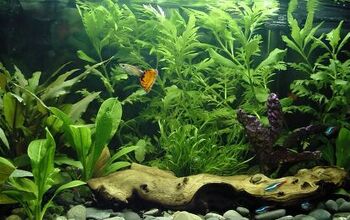Can You Sustain a Planted Tank Without a Filter?

If you are an experienced aquarium hobbyist, you undoubtedly understand the importance of having a high-quality filtration system installed in your tank. Having a filter is essential for maintaining high water quality because it removes harmful substances from the tank water and helps to keep oxygen levels high for your fish. If these are the main things a filter does, however, you may be wondering if the live plants in your tank will be enough.
What do Plants Do in the Aquarium?
Not only can live plants enhance the appearance of your aquarium, but they provide several very important benefits as well. Live aquarium plants go through the process of photosynthesis during the day (or when your tank lights are turned on) in order to grow. They absorb carbon dioxide from your tank water (this is produced by your fish as a byproduct of respiration) and they use light as energy to convert that carbon dioxide into oxygen. Live plants also extract certain pollutants from the tank water including things like ammonia, nitrate, and nitrite – all of these substances are harmful for your fish so it is necessary to have them removed from the tank. Aquatic plants can also help to keep algae growth at bay because they compete for the same nutrients algae needs to grow.
Related: What Aquarium Plants Need to Thrive
Do I Need a Tank Filter?
To summarize the information from the last section, live aquarium plants filter harmful substances from the tank water and convert carbon dioxide into oxygen. Given this information, you might be wondering what makes live plants different from any aquarium filter. After all, they seem to perform the same functions. So, do you really need to use a filter in your planted tank? The answer to this question will be different depending on several factors including tank size, the number of plants you have, and the number and type of aquarium inhabitants you are cultivating.
You can’t add one or two plants to your freshwater aquarium and expect it to be an adequate replacement for your filter. If you have a large tank or a large number of tank inhabitants, the ability of those few plants to filter out toxins and to produce oxygen will probably not be enough to keep up with the biological load of your tank. If, on the other hand, you have a moderately sized tank filled with a large number of live plants and you only have a few fish, those plants might be able to keep up with the production of waste and carbon dioxide your fish are responsible for.
Related: How to Use Aquatic Mosses in Your Planted Tank
The problem is that you will not really know if your planted tank can thrive without a filter unless you try it. Remember, it is essential that you cycle your tank before you add any fish or other tank inhabitants – this is still true for the planted tank. Having a filter installed while your tank is cycling can be beneficial, especially because you want the water quality to be high when you add your fish. It isn’t a bad idea, then, to start your planted tank with a filter and to keep adding more plants until your filter becomes unnecessary. Just make sure that you have another means of cultivating biological bacteria in your tank to maintain the nitrogen cycle once you remove the filter. You can try installing a sponge filter or simply let the bacteria grow on tank surfaces.
Things to Consider When Maintaining a Filtration System in Your Planted Tank
There are several reasons why maintaining a filtration system in your planted tank is recommended, even if you have a lot of plants in your aquarium. First off, because your plants will get the majority of the nutrients that they need to grow from the water, if there is even just a gentle flow created by the circulation that results from a filtration system, it could help them get the nutrients that they need more easily. And that translates to better plant growth. Plus, if you do have fish in your planted tank, the filtration that keeps the water clean can also help them stay healthy. The bottom line is that your plants and your fish can benefit from water that moves, rather than water that is stagnant, and a filtration system can help you achieve that.
When shopping for a filtration system for your planted aquarium, there are two main types that stand out from the rest and come highly recommended: hang on the back (or HOB) filters and canister filters. While you might think of undergravel filters, these aren’t a good choice for an aquarium with plants because the plants’ roots could end up getting in the way and preventing adequate flow. And cleaning your tank will be even harder when you have plants and an undergravel filter.
The great thing about an HOB filter is that it tends to be the more affordable option, and you can use it in smaller tanks. If you are going to use this type of filter in a bigger tank, you might need more than one to get the job done. Setting up and maintaining these filters is also easy, and it uses filter cartridges that are disposable. Just be sure you have enough space behind the tank in order for the HOB to fit properly.
Then there are canister filters, which are also easy to maintain. These are appropriate for larger tanks, as they aren’t the right choice for smaller aquariums. You can even use a spray bar attachment if you want to control the water return. Simply keep your spray bar attachment under the water to allow for the right amount of circulation throughout the tank. That simple step will be great for your fish and your plants. Also, in terms of location, you’ll set this one up under the tank, so this gives you more freedom because you won’t have to worry as much about leaving a lot of space behind the tank. And you can find canister filters that use reusable media.
There are other types of filtration systems available, but you need to bear in mind the fact that your tank is planted. For that reason alone, canister and HOB filters are the most often recommended products. Also, when shopping for the right filter for your planted tank, consider whether there are fish in the tank as well, and take into account the size of your tank too.
You Have the Option of Using a Filter or Not, but It Really Depends on Your Setup
It’s certainly possible to cultivate a thriving planted tank without a filter, but it can be a little bit tricky to accomplish. You want to make sure that your live plants are able to handle the biological load in your tank before you remove the filter and you need to take steps to ensure proper biological filtration. If you do these things, however, you can certain keep a planted tank without a filter.

Kate Barrington is the loving owner of two cats (Bagel and Munchkin) and a noisy herd of guinea pigs. Having grown up with golden retrievers, Kate has a great deal of experience with dogs but labels herself a lover of all pets. Having received a Bachelor's degree in English, Kate has combined her love for pets and her passion for writing to create her own freelance writing business, specializing in the pet niche.
More by Kate Barrington























